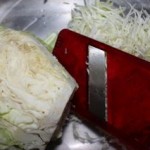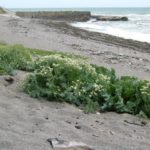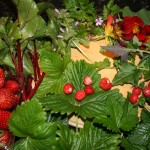Description
- other names three-cornered leek
- light green, grass like leaves and flower stalks are triangular in a cross section (photo below)
- it is a perennial that grows from small bulbs 1cm in diameter
- a garden escape being brought here by settlers from Europe
- even I considered it a terrible weed because it is impossible to get rid of
- through observation I realised it is a great ground cover in the cooler months, highly nutritious while it is there and then it dies down and disappears in the dryness of summer
- I completely changed my view of it and now I delight when I see it come up in late autumn/winter for using the leaves and flowers and even the roots as tasty additions to salads, pestos and smoothies, scrambled eggs or chopped up finely in butter
- roots can be dug up once the plant has died down and used like onions, spring onions or garlic
- although they are small the leaves when crushed have a distinct garlic smell so it is easy to identify
- the plant has beautiful bell shaped white flowers with a green stripe down the centre of each of the five petals
- flowers appear in spring, flower stalks reach 20-50 cm tall
Onion weed grows in gardens often in shade or under trees (it grew under my walnut tree in Palmerston North), parks, waste places and roadsides.
Nutritional Qualities
- contains sulphur (which gives it the onion flavour)
- helps reduce blood cholesterol levels
- acts as a digestive system tonic
- stimulates the circulatory system
- antimicrobial
- contains chlorophyll, fibre, antioxidants, vitamins and minerals
- take advantage of this winter green that comes to help protect us from colds and flu
Recipe: Julia’s Cultured Weed Salad
1/2 cabbage finely shredded
two huge handfuls of herbs & weeds e.g. chickweed, puha, onion weed, wall
lettuce, fennel, parsley, herb robert, dandelion, plantain, violet leaves, land or winter cress, endive, speedwell, mint, nasturtium leaves, herb robert, self heal, corn salad and red clover.
Method
- Place weeds on the cutting board and cut them all up at once into pieces 10-20cm
- Combine the weeds with the cabbage and sprinkle over 2 tsp of salt (this stops the ‘bad’ bacteria getting a head start, while the ‘gud’ cultures get growing) Let sit for 1/2 hour or longer
- Now comes the fun – massage the whole lot with your hands until the juice comes out and it looks all wilted (see below)
- Pack this into a quart jar and make sure there is a 20 cm gap between the lid & contents
- Push the plants down with a tamper or smaller bottle that fits into the jar to get all the air out (this is an anaerobic process) and to keep the plants under the liquid
- Place some pieces of dark green cabbage leaf into the liquid on top of the plant material
- Stand a smaller bottle with water in it on top of the cabbage leaves to keep it all down
- Put the lid on loosely and leave for 2-3 days, you’ll notice bubbles and the liquid expand this is all normal fermentation. The bubbling should lessen once the fermentation has completed store in the fridge.
- You can eat it as cultured vegetables with other food or put it in your smoothie! You heard correctly put a heaped Tablespoon in your smoothie and you’ll be doing yourself and your gut flora a big favour in having a dose of probiotics. The salt actually brings out flavours and you can’t really taste the cultured vegetables at all although you may smell it a bit.

Pack into a jar and use another bottle to hold down cabbage leaves placed on top of shredded material










When I was in France I noticed they sold pickled wild onion and wondered if it was the same. Along the roadside they had wild onion weed but it had pink flowers. I can remember using the onion plant in my cooking when i was camping. That is going back about 30 years.
Very interesting Jane – I’m sure there are different varieties with different flower colours. I’ve never seen pink flowering wild onion. Amazing that you used it 30 years ago! Would you use it again now I’m curious?
Hi Julia
One of my daughters purchased a house in Launceston, Tasmania with lots of Onion Weed.
I developed a hate relationship with “the weed” but since reading your article now have a fondness for Three Cornered Leek!!
Thanks heaps, will sign up for your newsletter 😊 Gary
HI Gary, sorry I took so long to reply – I saw your message when I was over on Great Barrier Island off the coast of the North Island but didn’t get to reply. So glad you’ve had a change of relationship with onion weed!! Here it is flowering and looks so pretty and the leaves are all so lush. So I’ve been using it quite a bit – it is after all food we haven’t had to labour over growing. And the bonus is it all goes to sleep over summer!! Thanks very much for sharing that change in your perspective!!
Hi. Julia,
For 19 years I’ve lived in a house where the onion weed has gone crazy along the driveway and into the front lawn and even the nature strip. I considered them the bane of my weeding existence. Until I saw RachEl Khoo use the flowers in a salad. I’m trying them for the first time tonight, and now thinking about preserving the bulbs…but not in vinegar… some sort of brine, I think.
Wow you have had a shift in perspective towards this weed to now be eating the flowers which are tasty aren’t they and the bulbs. I’ve heard of people pickling them but I haven’t done it myself. One way to preserve them is in cider vinegar or salt and water. I use the leaves a lot in smoothies and pestos. Over summer the plants will be completely died down and that would be a good time to use the bulbs who’ve been filled with nutrition from the leaves. Thanks so much for writing!!
Thanks for your response. I love the pesto idea. Now my mind is going haywire. What about Tart Tartin? Onion weed bread, Onion weed green curried chicken or beef? Pizza toppings…OMG…droooooooling. 😀
That is fantastic Mark – you’re obviously a good cook!! Who wouldn’t go wild thinking up recipes when it is a source of tasty onion/garlic flavor provided by nature without our help – that is why I totally love it!!
I have something like this growing everywhere and it has been since October. But its leaves are not triangular, they are round. I am in the southern US if that matters.
Just be careful it doesn’t sound like it’s the same and could be snowdrops which look similar but I don’t think they are edible.
HI Lois, thank you for writing this cautionary note. Yes both flowers are white but onion weed has a stripe down each petal and snowdrops don’t. Also onion weed has a distinct smell of onions and garlic, whereas snowdrops don’t.
This link goes to photos of snowdrops and you can see they are quite different.
https://www.google.co.nz/search?q=snowdrop+image&client=firefox-b&dcr=0&tbm=isch&tbo=u&source=univ&sa=X&ved=0ahUKEwim5c6zvvHWAhVLUrwKHdR3AsMQ7AkIQg&biw=1280&bih=633
If the link doesn’t work google ‘snowdrop’ images and you’ll be able to see what they look like.
I have this weed growing in my garden like crazy this time. I used to have this but took them out all. This time, I took them out almost all again, but left some because I remembered a Chinese woman using this in her documentary movie in NZ. I simply chopped and used in a clear soup. I liked it. Now, I hope the onion weed comes back in my garden every year. I was not sure whether flower is edible and it is good to know that is edible.
HI Marisa, great to hear from you and I’m so glad you’ve had a change of heart over the onion weed. It is your free spring onions and great in recipes that use onions. I am sure it will come back. Then you will see the dainty white flowers in spring time. I think they are so pretty.
Thanks Julia, I have had an acre of onion weed. It always used to be the bane of my life because it was so thick and matted I couldn’t successfully grow anything else in the rocky soil. I very occasionally used the onion weed in cooking because I’ll experiment with almost anything given the slightest encouragement. But until reading this article I never had confidence to use lots of it. Interestingly I have about 4 different varieties – one looks as if it was a cultivated variety and that it would be perfect in pickles – my plot was originally cleared by migrants so I’m wondering if it was planted. Now, the secret for reducing the onion weed for me has been my free range hens! They love the flowers and tips of the leave so the weed has been thinning over the years. I’m sure there will always be enough for cooking though!